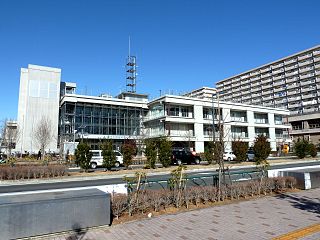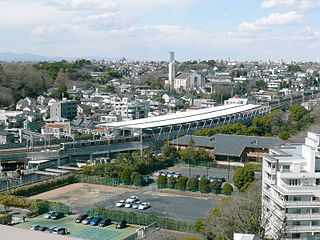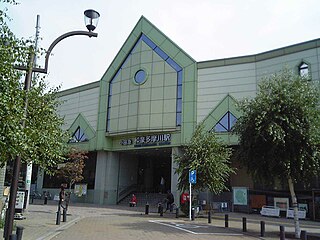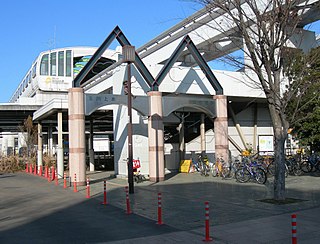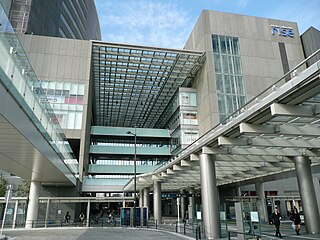
Tamagawa Aqueduct(玉川上水Tamagawa Jōsui) is a 43 km long Japanese aqueduct located in Tokyo. It was constructed by the Tokugawa shogunate to supply drinking and fire-fighting water from the Tama river to Edo, providing irrigation water around farm villages.

An aqueduct is a watercourse constructed to carry water from a source to a distribution point far away. In modern engineering, the term aqueduct is used for any system of pipes, ditches, canals, tunnels, and other structures used for this purpose. The term aqueduct also often refers specifically to a bridge on an artificial watercourse. The word is derived from the Latin aqua ("water") and ducere. Aqueducts were used in ancient Greece, ancient Egypt, and ancient Rome. In modern times, the largest aqueducts of all have been built in the United States to supply the country's biggest cities. The simplest aqueducts are small ditches cut into the earth. Much larger channels may be used in modern aqueducts. Aqueducts sometimes run for some or all of their path through tunnels constructed underground. Modern aqueducts may also use pipelines. Historically, agricultural societies have constructed aqueducts to irrigate crops and supply large cities with drinking water.

The Tokugawa Shogunate, also known as the Tokugawa Bakufu (徳川幕府) and the Edo Bakufu (江戸幕府), was the last feudal Japanese military government, which existed between 1603 and 1867. The head of government was the shōgun, and each was a member of the Tokugawa clan. The Tokugawa shogunate ruled from Edo Castle and the years of the shogunate became known as the Edo period. This time is also called the Tokugawa period or pre-modern.

Edo, also romanized as Jedo, Yedo or Yeddo, is the former name of Tokyo. It was the seat of power for the Tokugawa shogunate, which ruled Japan from 1603 to 1868. During this period, it grew to become one of the largest cities in the world and home to an urban culture centered on the notion of a "floating world".
The aqueduct was created following a request for permission from the people of Kojimachi and Shibaguchi to build another aqueduct, drawing the waters of the Tama river. The government provided 7,500 ryō for the construction, 3,000 ryō were collected by public subscription. Construction on the 43 km long aqueduct, which runs from Hamura, Tokyo to Yotsuya, Tokyo, began in April 1653. The section from Hanemura to Ōkido was fully excavated within eight months and the entire aqueduct was completed in eighteen months. The project was undertaken by the Seiemon brothers who were awarded the surname "Tamagawa" in honour of their accomplishment. Prior to the construction, the two brothers were considered "mere peasants". [1] [2] Before the construction of the aqueduct the city was served by a single, and insufficient, Kanda Aqueduct. [3]
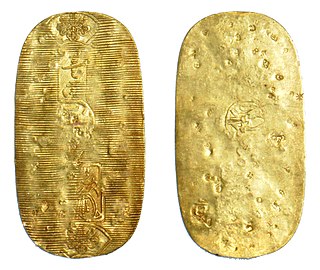
A Ryō (両) was a gold currency unit in pre-Meiji Japan Shakkanhō system. It was eventually replaced with a system based on the yen.

Hamura is a city located in the western portion of Tokyo Metropolis, Japan. As of 1 February 2016, the city had an estimated population of 55,596, and a population density of 5620 persons per km². Its total area is 9.90 square kilometres (3.82 sq mi).
In 1948, Osamu Dazai, considered one of the foremost fiction writers of 20th-century Japan, and his mistress Tomie Yamazaki, drowned themselves in the aqueduct together. Dazai had been living in Mitaka, Tokyo, through which the aqueduct runs, since 1939. [4]

Osamu Dazai was a Japanese author who is considered one of the foremost fiction writers of 20th-century Japan. A number of his most popular works, such as The Setting Sun (Shayō) and No Longer Human, are considered modern-day classics in Japan. With a semi-autobiographical style and transparency into his personal life, Dazai’s stories have intrigued the minds of many readers.

Mitaka is a city located in the western portion of Tokyo Metropolis, Japan. As of 1 February 2016, the city had an estimated population of 189,168, and a population density of 11,520 persons per km². Its total area is 16.42 square kilometres (6.34 sq mi).
- Tamagawa Aqueduct in Hamura 35°44′57.84″N139°18′59.49″E / 35.7494000°N 139.3165250°E
- Tamagawa Aqueduct in Tachikawa 35°43′41.74″N139°25′48.59″E / 35.7282611°N 139.4301639°E
- Tamagawa Aqueduct in Koganei 35°42′45.46″N139°31′05.36″E / 35.7126278°N 139.5181556°E
- Tamagawa Aqueduct near Daitabashi Station, Setagaya 35°40′15.96″N139°39′36.21″E / 35.6711000°N 139.6600583°E
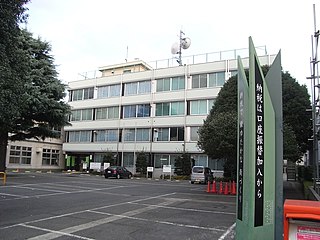
Koganei is a city located in the western portion of Tokyo, Japan. As of 1 February 2016, the city had an estimated population of 121,516, and a population density of 10,750 persons per km². Its total area is 11.30 square kilometres (4.36 sq mi).

Daitabashi Station is a railway station on the Keiō Line in Setagaya, Tokyo, operated by the private railway operator Keio Corporation.













